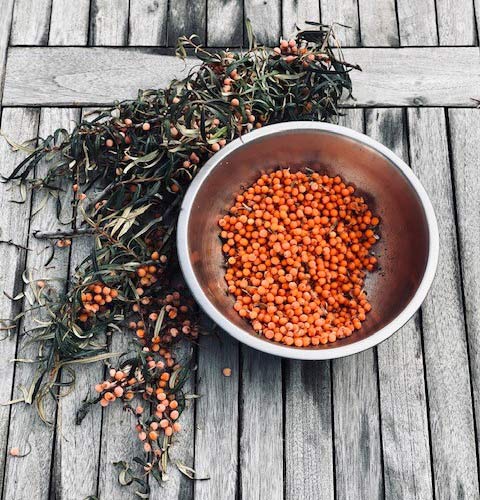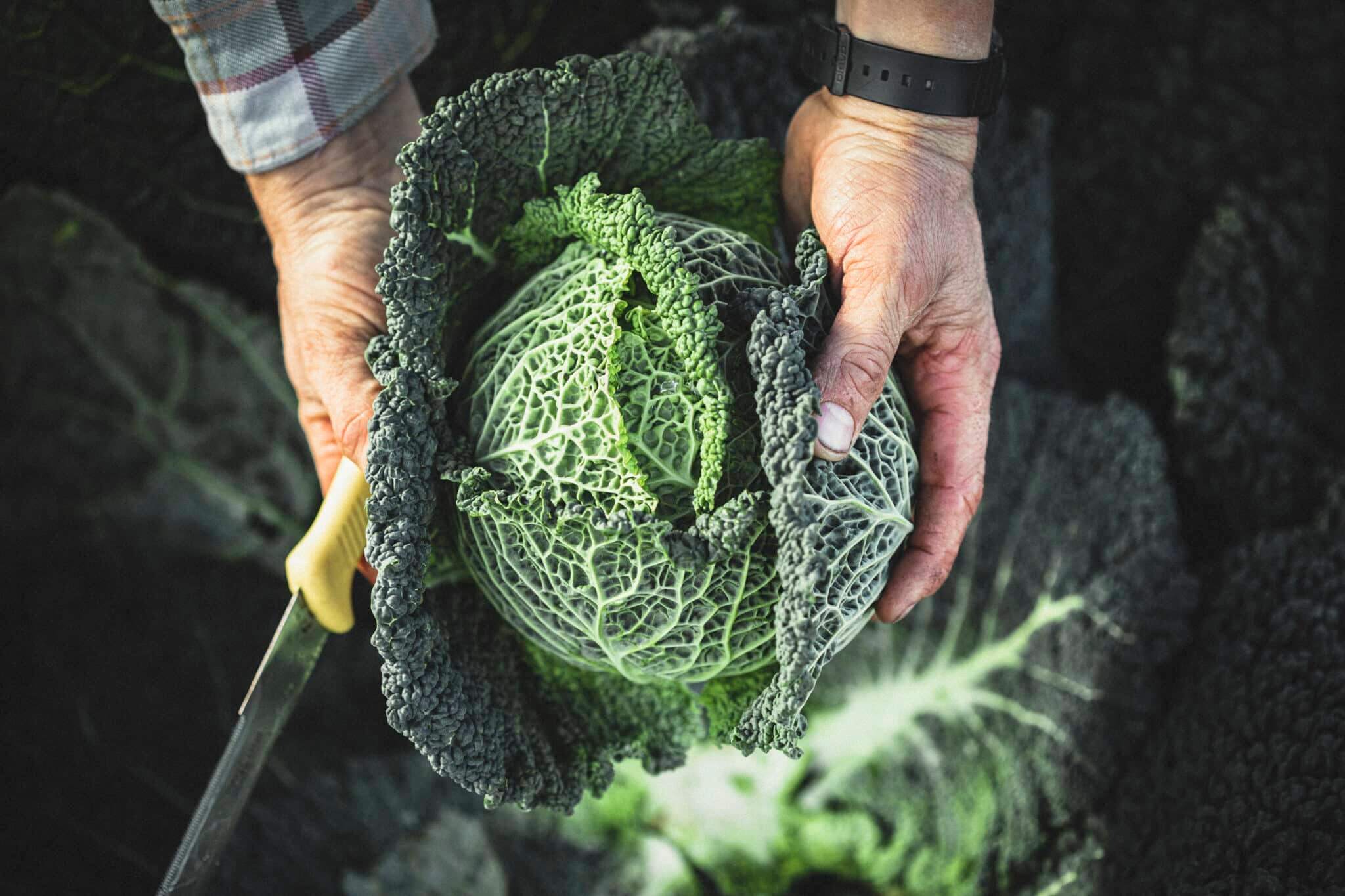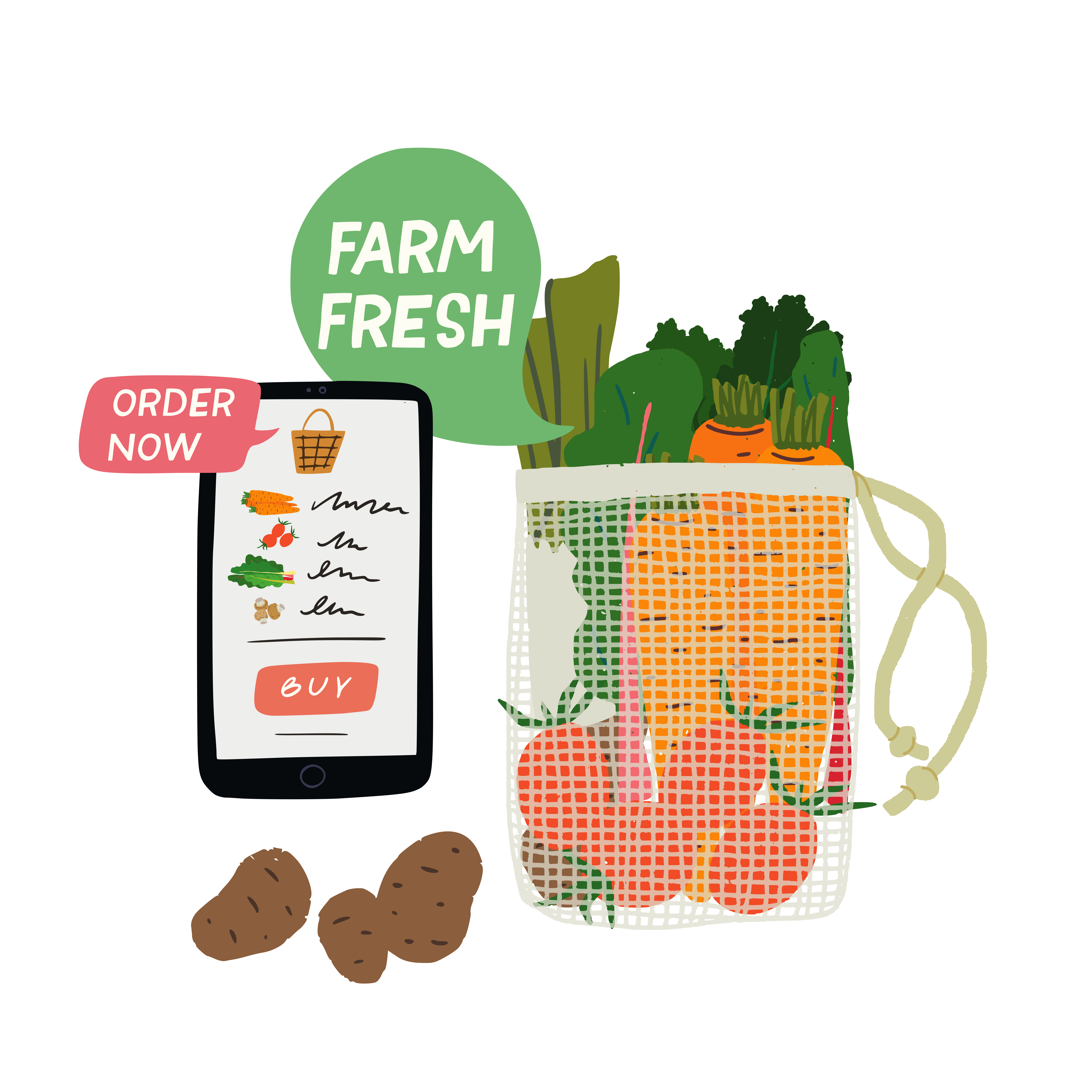Autumn is the season of fruitfulness, but you don’t have to rely on what others pick for you. Head chef at The Riverford Field Kitchen restaurant, Lewis Glanvill, and foraging expert Stuart Woodman share their top tips for what to forage and where to find it…
Sea buckthorn
This sea buckthorn was foraged from a secret riverside spot in Totnes, close to Riverford’s farm. These intensely citrus and vibrant berries featured in one of the Field Kitchen’s menus in a sea buckthorn tart served with hay cream. ⠀⠀
 ⠀⠀⠀⠀⠀⠀⠀⠀⠀⠀⠀⠀⠀⠀⠀
⠀⠀⠀⠀⠀⠀⠀⠀⠀⠀⠀⠀⠀⠀⠀
The sea buckthorn plant can be found clinging to rocks along the coast or in a sunny spot near rivers. The berries are packed with Vitamin C and Vitamin B12, especially important for vegetarians, and they can be used as a health-packed (and free) alternative to citrus fruits. You can use them in puddings, fish dishes, stirred through yoghurt, juiced to create a superfood drink or added to jam to give you morning vitamin boost to start the day on. The berries are at their best during September to November, so now is the perfect time to head to the beach for a forage.
Sloes
Sloe gin has been growing in popularity over the years and deservedly so. But if the birds or other more organised foragers have beaten you to the berries this year, then you can still capture their cherry almond flavour by using the leaves. To do this, create a simple syrup of one part sugar and one part water and infuse the leaves in the syrup for a few days before straining off. The syrup can be used in puddings, cordials or cocktails.
Blackberries
There’s been a bumper crop of juicy blackberries around the hedgerows at our farm in Devon and the team have been busy making them into a cordial to serve to dining guests and to be mixed with prosecco for a wedding.⠀⠀⠀⠀⠀⠀⠀

To create a blackberry cordial at home, you’ll need 750g blackberries, 250g sugar and the juice of 1 lemon. Put 150ml water, the blackberries and lemon in a pan and cook through on a low heat for 10-12 minutes. Take off the heat and strain, and use a wooden spoon to gently move the mixture around to extract all of the juice. Transfer the juice to a medium saucepan and add the sugar. Gently stir over a low heat until all of the sugar has dissolved and then bring to the boil before immediately removing from the heat and pouring into a sterilised bottle.
Wild fennel
Fennel is a relatively common plant that can be found in hedgerows, fields or anywhere close to the coast. At this time of year, the flower heads have gone to seed and now is the ideal time to head out with a paper bag to shake the seed heads and start collecting the seeds. We’re lucky enough to have a number of wild fennel plants on the banks outside our restaurant. Earlier this week, we collect the seeds to add to our wild nettle and fennel seed focaccia.

Elderberries
Elderberries are the fruit of elder tree that are produced in September and October on the stalks of the elderflower heads. Worth knowing that if you completely strip your favourite elder tree of flower heads in spring, then you won’t be able to benefit from the berries in autumn. Elderberries are antiviral and antioxidant making them great for your immune system as well as a tasty snack. ⠀⠀⠀⠀⠀⠀
One of our favourite ways to capture their tart and tangy taste is to ferment them in honey. We then use them in salads and on roasted veg dishes. They also make a mouth-watering addition to puddings or stirred through mascarpone or yoghurt and granola for breakfast. They work really well in savoury dishes too. It’s important to remember elderberry stems, leaves and unripe berries are toxic so be sure to remove these before starting the recipe.

Place the elderberries into a wide mouthed sterilised jar and cover in honey. Volumes depend on what you have available and how much you want to produce. Place lid loosely on jar and put in a dark place out of direct sunlight. Turn your jar every few days, making sure you’ve tightened the lid. This ensures all the berries are coated in honey. Within a few days you will see bubbles starting to form. Ferment for up to 1 month then store at room temp for up to a year. Strain the elderberries and use.
Pineapple weed
Commonly found from May to October, pineapple weed is often seen in poor or compacted soil alongside footpaths, or in disturbed soil that’s been ploughed and left fallow. As its name suggests, the plant has a surprising tropical pineapple flavour. Create a simple sugar syrup (one part water and one part sugar) and leave the heads to infuse and then use the syrup over roasted vegetables, in vinegar or as a cocktail ingredient.
Crab apples

Crab apples are at their peak picking potential at this time of year. If you head out to your local park or take a walk along a country lane, you’re likely to eventually come across a tree laden with these red or yellow fruits. If eaten raw, their flavour ranges from tart to slightly sweet depending on the variety. When combined with other ingredients they provide a tart apply note that tastes of the season itself. In the Field Kitchen we often use them in puddings, but they’re also rich in pectin, so they make a great addition to jams and chutneys to help them set.
Stuart Woodman hosts a number of foraging walks and events at The Riverford Field Kitchen, with his 2020 course and dining dates at the restaurant coming soon.













0 Comments